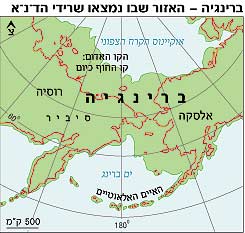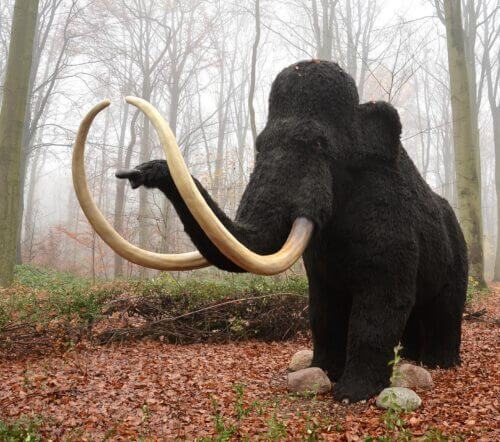The remains of the material found in Siberia contain the DNA of 28 plant families and of mammals such as horses and buffaloes


The DNA remains that were recently discovered in Siberia have already been awarded the title of "the oldest genetic material in the world". For about 400 years, the remains remained in frozen alluvial sediments - which prevented the molecule from breaking up. In an article published this week in the journal "Science", the researchers claim that the DNA of 28 plant families, including trees, shrubs, plants and types of moss, remains in the alluvial layer. In addition, remains of the genetic load of eight ancient species of mammals, including mammoths, horses and buffalo, were found in the drift.
The DNA remains that have been found will allow researchers to verify previous scientific assertions, which have so far been subject to controversy, such as the question of what the steppes of northeastern Siberia, known as "Beringia" looked like 20 years ago? According to one hypothesis, the area was a polar desert with very little life and vegetation. The DNA remains have already succeeded in confirming the second hypothesis, according to which the area was rich in frozen steppe vegetation, and many species of animals grew there.
The findings may also help solve one of the great mysteries of the ancient world: what caused the extinction of the mammoths? From the DNA samples, the researchers conclude that until the Ice Age, the land in Siberia was covered with grass. At the end of the Ice Age, 22-16 years ago, the land began to be covered with aquatic swamp plants. Climate change probably caused the extinction of the mammoths. Even in this case it is a hypothesis, as with the theories that try to explain why the dinosaurs became extinct at the end of 160 million years of prosperity on Earth. The solution to the mystery may be obtained from the analysis of the genetic load of the mammoths.
In recent years, 50 years after the discovery of DNA by James Watson and Francis Crick, genetic research is gaining momentum. Just last week, an international team of scientists announced that they had finished mapping the human gene sequence. Although they cannot change the gene sequence, the researchers hope to develop innovative drugs that can help patients by neutralizing certain genes, or encouraging other genes.
When the American writer Michael Creighton wrote his book "Jurassic Park", genetic mapping was just an idea. In the early 90s, Creighton put forward the idea in his book that it is possible to resurrect animals that have become extinct throughout evolution, using their DNA remains. In the book, which was adapted into a blockbuster movie, the scientists isolated the DNA of the dinosaurs that went extinct 65 million years ago. Using today's animals, the scientists manage to breed new dinosaurs based on the remains of the ancient genetic material.
But unlike in the book, Creighton's vision is not easy to execute. The DNA found in Siberia is broken into tiny particles, so it cannot be put back together. As a result, extinct animal species cannot be re-cloned and resurrected. "Right now cloning is an impossible matter for us," says one of the researchers who examined the findings, Thomas Gilbert from the Center for Ancient Biomolecular Science at the University of Oxford. "For this, the complete DNA of the animal is required and a primitive cell needs to be built in which the DNA is implanted."
However, although the genetic load in Siberia did not survive in its entirety, the researchers hope to soon find complete DNA samples, and perhaps even more ancient ones, in the Siberian steppes. Now, after finding the mammoth's DNA, Creighton's vision seems closer than ever. If the scientists succeed in realizing the second stage of his plan, it will be possible to resurrect animals such as dinosaurs, mammoths, and the dodo bird. These days, a team of Scottish scientists is trying to trace the Tasmanian tiger tribe, which became extinct only in the 20th century, using DNA remains left over from it.
Boxa: The Race for the DNA
Siberia provided the oldest DNA sequence in the world: a 400 thousand year old plant
The oldest confirmed specimen was extracted from the depths of the earth in the frozen plains of Siberia.
The DNA belongs to grasses, shrubs and swamp plants estimated to be 300 and 400 years old. So far, the oldest confirmed plant sample was 20 years old, and the oldest animal DNA sample is 50 years old. This is what the journal Nature reported in its issue of April 14, 2003.
Analyzing DNA sequences from soil samples may open a window into the ancient environment, said Eske Willerslev, a molecular biologist at the University of Copenhagen in Denmark who led the study. "We have shown that macrofossils are not necessary to obtain information about past habitats." said.
Hendrik Poinar, a molecular evolutionist at the Max Planck Institute for Evolutionary Anthropology in Leipzig, Germany, agrees. "Scientists will now be able to access samples stored for years in museums and scan them for plant and animal cells." said.
Although there is evidence of plants and animals hundreds of millions of years old, extracting an identifiable DNA sample from them was not possible because the DNA was destroyed. However, scientists continue to search for DNA sequences that are not completely broken.
Willerslav's team chose an area in northeastern Siberia where a selection of animal fossil deposits - including a type of lemming - are known to have existed during certain periods of prehistory. The team excavated pits from a depth of 2-30 meters, between the Kolyma and Lena rivers.
They looked for fragments of the chloroplast DNA of plant pollen. The chloroplast is an energy-generating sub-component of the plant cell, and has DNA separate from that of the pollen.
Ancient pollen cells are found in sediment cores. However, pollen can fly great distances with the wind. By focusing on chloroplasts, the team discerned which plants grew at the excavated spot. They found evidence that grasses, swamp plants and shrubs inhabited the area until ten thousand years ago.
The team also found bits of animal DNA. Examples of mammoth, bison and horses have been found. They all lived in the area during most of the last ice age that peaked 18 years ago. The researchers plan to repeat the experiments in other frozen areas and caves. Then they will move to warmer environments to see if the DNA survives there as well.
